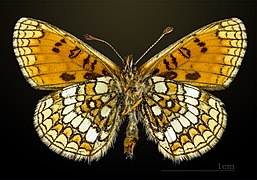Bündner Scheckenfalter
| Bündner Scheckenfalter | ||||||||||||
|---|---|---|---|---|---|---|---|---|---|---|---|---|

Bündner Scheckenfalter ( Melitaea varia ) |
||||||||||||
| Systematics | ||||||||||||
|
||||||||||||
| Scientific name | ||||||||||||
| Melitaea varia | ||||||||||||
| Meyer-Dür , 1851 |
The Bündner Scheckenfalter ( Melitaea varia ) is a butterfly (day butterfly ) from the noble butterfly family (Nymphalidae).
features
butterfly
The moths are among the smaller piebald butterflies and reach a wingspan of around 24 to 28 millimeters. They are orange to brown-orange in color and have a pattern of black cube spots and cross bars. Characteristic is an often reduced drawing on the submarginal and post-disc regions of the forewings . The females are mostly dusted a little darker. On the undersides of the hind wings alternating orange-yellow and white bands can be seen. At the edge there are whitish marginal moons, which then border on orange-yellow fields.
Caterpillar, pupa
The caterpillars are plump and blackish gray in color, have numerous small, white spots and many conspicuous, yellowish thorns. The doll shows a very distinctive, black and white patterned appearance.
Similar species
- Western pied butterfly ( Melitaea parthenoides ). This species is larger, shows a clearer grid pattern and has fox-red palps , which are usually dark brown in varia . In addition, it flies in lower regions, so that there is hardly any overlap in the flight area.
Occurrence
The animals are found in the Alps at altitudes between 1500 and 2600 meters - especially in the Swiss cantons of Valais and Graubünden (including in the Engadine ) - which is where the German name Bündner Scheckenfalter is based. They are sometimes very numerous there. Other occurrence regions are the Ortler area in South Tyrol , the Alpes-Maritimes and Drôme departments in France , higher altitudes in Tyrol in Austria and the high altitudes of the Apennines and Abruzzo .
Way of life
The moths fly in one generation from the end of June to the end of August, preferably on short-grass, flower-rich alpine meadows and slopes. Usually the females lay the eggs in larger groups on the forage plant. The caterpillars initially live gregariously and overwinter, then they can be found individually. They feed on various low -growing plants such as alpine plantain ( Plantago alpina ), spring gentian ( Gentiana verna ) and Koch's gentian ( Gentiana acaulis ).
Danger
The species is considered potentially endangered (nt) in Switzerland. The species does not occur in Germany, so that it is not classified on the German Red List of endangered species .
swell
Individual evidence
- ↑ Walter Forster , Theodor A. Wohlfahrt : The butterflies of Central Europe. Volume 2: Butterflies. (Rhopalocera and Hesperiidae). Franckh'sche Verlagshandlung, Stuttgart 1955, DNB 456642188 .
- ^ A b Tom Tolman, Richard Lewington: The butterflies of Europe and Northwest Africa , Franckh-Kosmos Verlags-GmbH & Co, Stuttgart 1998, ISBN 3-440-07573-7
- ↑ Federal Office for the Environment FOEN, Swiss Center for the Cartography of Fauna (SZKF / CSCF) (editor): Red List of Butterflies and Ramies 2014 Page no longer available , search in web archives: online
literature
- Tom Tolman, Richard Lewington: The butterflies of Europe and Northwest Africa , Franckh-Kosmos Verlags-GmbH & Co, Stuttgart 1998, ISBN 3-440-07573-7
Web links
- Lepiforum e. V. Taxonomy and Photos
- www.pyrgus.de - photos and ecology
- www.nic.funet.fi - dissemination
- Fauna Europaea - Taxonomy
- Melitaea varia inthe IUCN 2013 Red List of Threatened Species . Posted by: van Swaay, C., Wynhoff, I., Verovnik, R., Wiemers, M., López Munguira, M., Maes, D., Sasic, M., Verstrael, T., Warren, M. & Settele, J., 2009. Retrieved February 18, 2014.



